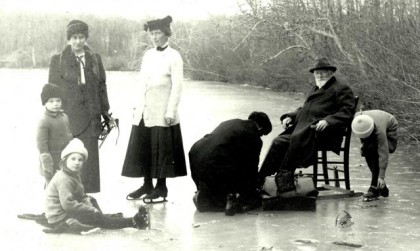
Thinking about a nature preserve in my neighborhood has helped me come to a clearer understanding of how the concept of ecosystem services relates to the value people had for nature during previous generations.
As a born-this-way nature lover, I have been struggling to understand why we need “ecosystem services” rationales for environmental conservation.
In a nutshell, an ecosystem services argument for conservation states that we all need (and ought to value) nature for the economic benefits it provides to society.
I wrote in my last post about Bennett Bogs, a tiny natural area in a tiny corner of the world that played an important role in the lives of people living near it.
Through the 18th, 19th and early 20th centuries the bogs were used for various activities — haying, ice skating, brick making, cranberry picking, duck hunting, and yes, nature appreciation in the form of botany.
My key realization relating to ecosystem services is that all those people using the bogs were not necessarily nature lovers, but they nonetheless valued the place.
There were probably just as many people then as there are now who couldn’t care less about the unique botanical diversity of the bogs. But back then there were more ways to appreciate the value of the place without being a true nature lover.
Now the list of quaint activities people enjoy at the bogs has been reduced to one: botany.
At this point in history, two things have diminished the value that a non-nature lover might have for nature.
One is our inevitable progression toward a globalized world, where we don’t subsist on what is out our backdoor. We don’t really need the neighborhood woodlot and meadow for anything. We buy our cranberries at the grocery store.
The other is the approach the conservation movement has taken to the management of protected lands.
One of the primary currencies of conservation has been land protection. Along with this land protection came restrictions on how the land was used. These new restrictions often excluded people who had previously been extracting value (i.e. resources or even some forms of recreation) from these places.
In reacting to a previous era of rampant environmental exploitation, conservation swung the other direction and put a stop to most everything.
But such “fortress conservation” may have had unintended consequences.
When Bennett Bogs became protected it is likely that some of the locals were alienated.
People could no longer engage in some of the traditional uses of the place. The uses allowed were narrowed down to a single one – nature appreciation.
And the only advocates for the place left were those folks who knew and appreciated the exquisite orchids that grew there.
There is a decreasing level of support for conservation because there are only so many nature lovers out there — those that appreciate the so-called intrinsic value of nature.
Protected land management has often gone as far to alienate even the nature lovers, prohibiting removal or disturbance of any plant and animal.
For example, I recently saw a presentation by a pair of ardent bug lovers who went on a insect-collecting road trip to the southwest U.S. They pointed out that one of their challenges was finding the seams between conserved land where they could ply their trade legally.
Another contemporary example of a prohibited non-nature-loving use of our conservation lands is ATV riding. Could they be conservation allies and advocates for open space instead?
Finding a way to compromise with bug killers and noisy, destructive off road vehicle enthusiasts would be challenging, but conservation can’t afford to keep alienating potential allies.
While we are not able to re-create the quaint pre-modern scenes of subsistence use of nature, there are still opportunities to build alliances with non-nature lovers and increase “the constituency for nature”.
The other opportunity to increase this constituency, I have realized, is to convince the people who never set foot in the woods that there is something in it for them. Ecosystem services concepts attempt to demonstrate the value of nature to all those people out there who aren’t necessarily nature lovers.
This is a lot more work than taking someone cranberry picking and ice skating. We’ve gone from direct and tangible values to more abstract arguments about the benefits of (for example) forests in reducing water treatment costs and sequestering carbon.
The rub is that much of the valuing of nature by non-nature lovers amounts to the exploitation of nature — the very thing the conservation movement was reacting to in the first place.
Ecosystem services rationales tell us that nature is valuable for the fish, game, timber, minerals and anything else that might be extractable, along with the more passive and benign services as watershed protection, pollination and carbon storage.
Expanding support for conservation means embracing these exploitative elements while making calls for sustainable use of resources. And it also means embracing the concept of ecosystem services, convincing as many people as possible that the benign exploitation of nature for societal benefit makes good business sense.
It is difficult to know if this gambit will bring the additional support for conservation that is needed, but thanks to some utilitarian bog-haunters of yore, I get it!